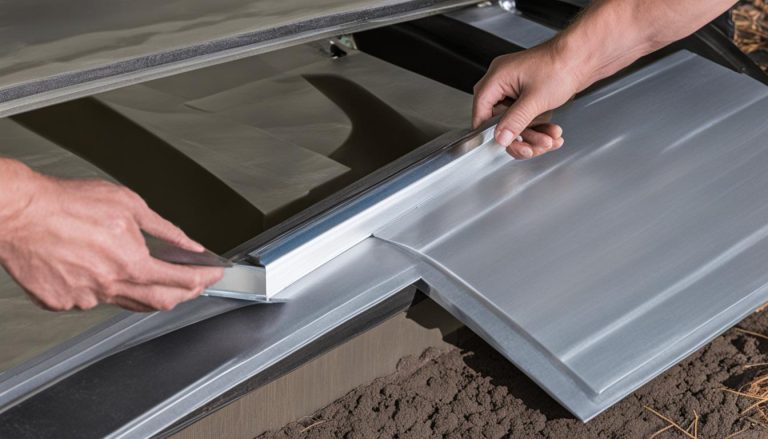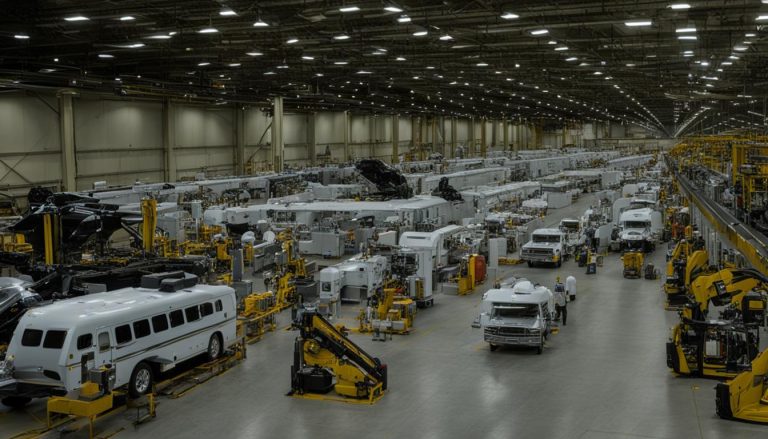Sanitize Your RV Water Tank: A Step-by-Step Guide
gorvlifestyle.com and its partners may earn a commission if you purchase a product through one of our links
To ensure safe and clean water in your RV, it is important to regularly sanitize your RV water tank. Most RVs have three holding tanks, but the fresh water tank is the one responsible for providing safe water for drinking, showering, and washing dishes. Sanitizing the tank should be done at least once a year, or every time the RV has sat unused for 2-4 weeks. This routine maintenance task can be done using bleach or a more environmentally-friendly cleaning solution.
Key Takeaways:
- Regularly sanitize your RV water tank to ensure safe and clean water for drinking, showering, and washing dishes.
- Sanitization should be done at least once a year or every time the RV has sat unused for 2-4 weeks.
- Consider using bleach or an environmentally-friendly cleaning solution to sanitize your RV water tank.
- Follow a step-by-step guide to effectively sanitize your RV water tank.
- Maintain a clean RV water tank by implementing regular cleaning and inspection practices.
How Often Should You Sanitize Your RV Fresh Water Tank?
Ensuring the cleanliness and safety of your RV’s fresh water tank is crucial for providing safe water during your travels. But how often should you sanitize your RV water tank to maintain optimal conditions? Let’s explore the recommended intervals for sanitizing your RV fresh water tank.
According to most manufacturers, the general guideline is to sanitize your fresh water tank “after each use.” However, it is often interpreted as sanitizing the tank at least once a year during spring dewinterization or every 2-4 weeks of inactivity. These timeframes ensure that your water remains clean and free from any harmful bacteria or contaminants.
Regular sanitization of your RV water tank guarantees safe water for various purposes, including drinking, showering, dishwashing, and laundry while on the road. It provides peace of mind, knowing that you and your family are consuming clean water, reducing the risk of potential health issues.
By following the recommended intervals for sanitizing your RV fresh water tank, you can maintain the cleanliness and integrity of your water system, ensuring a comfortable and healthy travel experience.
What Do You Need to Sanitize your RV Fresh Water Tank?
Sanitizing your RV fresh water tank is a simple task that doesn’t require any special tools. Here are the necessary items you’ll need:
- A measuring cup
- A funnel
- A 5-gallon bucket or water storage container
- A potable water hose
- Non-scented bleach or RV tank sanitizer
It is important to use non-scented bleach or designated RV tank sanitizer to avoid damaging the components of your RV’s water system. This ensures that your tank is properly sanitized and ready to provide clean and safe water during your travels.
Necessary Items for RV Water Tank Sanitization
| Item | Description |
|---|---|
| Measuring cup | A cup for accurately measuring bleach or sanitizer |
| Funnel | A tool for easily pouring bleach or sanitizer into the tank |
| 5-gallon bucket or water storage container | A container for mixing the sanitizing solution |
| Potable water hose | A hose for filling the tank with fresh water |
| Non-scented bleach or RV tank sanitizer | A sanitizing agent to remove bacteria and contaminants |
Having these items on hand will make the process of sanitizing your RV fresh water tank quick and easy. Now let’s move on to the step-by-step guide for effectively sanitizing your tank.
How To Sanitize RV Fresh Water Tank with Bleach
The bleach method is one of the most commonly used techniques for sanitizing an RV water tank. Using bleach to sanitize your RV water tank is a straightforward process that ensures your water remains clean and safe for use. Below is a step-by-step guide for sanitizing your RV water tank with bleach:
- Before starting, turn off your water heater and water pump to avoid any accidents or damage.
- Drain your fresh water system, including the water tank and plumbing lines. This will remove any residual water and debris.
- Calculate the amount of bleach needed based on the size of your fresh water tank. Generally, you will need 1/4 cup of bleach for every 15 gallons of water tank capacity.
- Mix the bleach with water in a separate container and use a funnel to pour the mixture into the fresh water tank.
- Fill the tank with potable water, ensuring that the bleach solution is evenly distributed throughout the tank.
- Pump the water through the system, allowing the bleach solution to circulate. This will ensure that all parts of the tank and plumbing lines are thoroughly sanitized.
- Let the water sit in the tank for 12-24 hours to effectively kill any bacteria or contaminants.
- After the designated time, drain the tank and flush the system with clean, fresh water multiple times to remove any remaining bleach residue.
Following these steps will ensure that your RV water tank is effectively sanitized and ready for use. Remember to always use caution when working with bleach and follow the manufacturer’s guidelines for best results.
Alternative Methods for RV Water Tank Sanitization
While the bleach method is effective, some RV owners prefer to use alternative methods for sanitizing their water tanks. These methods include using vinegar, hydrogen peroxide, or commercially-available RV tank sanitizers. These alternatives are often considered more environmentally-friendly and may be preferred by those with sensitivities to bleach.
| Alternative Method | Description |
|---|---|
| Vinegar | Mixing white vinegar with water can create a natural cleaning solution capable of removing bacteria and odors from the RV water tank. After draining the tank, fill it with a mixture containing 1 cup of vinegar for every 5 gallons of water. Let the solution sit for at least 12 hours before flushing the tank. |
| Hydrogen Peroxide | Hydrogen peroxide is another non-bleach option for sanitizing an RV water tank. To use this method, simply fill the tank with a mixture of water and hydrogen peroxide in a 5:1 ratio. Allow the solution to sit for several hours before flushing the tank. |
| RV Tank Sanitizers | There are commercially-available RV tank sanitizers specifically designed for water tank disinfection. These products are formulated to effectively remove bacteria and algae while being safe for RV water systems. Follow the instructions provided by the manufacturer for proper usage and dilution. |
When using any alternative method, it is important to follow the recommended instructions and ensure thorough rinsing of the tank before using the water system. Additionally, consider conducting regular water tests to ensure the effectiveness of the sanitization method chosen.
The image above illustrates some of the alternative techniques and products available for sanitizing RV water tanks, providing RV owners with options that suit their preferences and needs.
Remember that regardless of the method chosen, regular maintenance and sanitization of your RV water tank is vital to ensure clean and safe water for your travels.
Maintaining a Clean RV Water Tank

Keeping your RV water tank clean is essential for ensuring the safety and quality of your water supply. By following a few simple tips and strategies, you can prevent contamination and maintain a clean water tank throughout your travels.
Tips for Maintaining a Clean RV Water Tank:
- Regularly sanitize the tank: Follow the recommended guidelines for sanitizing your RV water tank, typically once a year or after extended periods of inactivity. This process helps eliminate any bacteria or contaminants that may have accumulated over time.
- Avoid filling with non-potable water: It’s important to only fill your RV water tank with clean, potable water from a trusted source. Avoid using water from unknown or questionable sources, as it may contain harmful substances that can lead to tank contamination.
- Use a filter when filling the tank: Installing a water filter on your RV’s water inlet hose can help remove impurities and sediment, ensuring that the water entering your tank is clean and free from debris.
- Inspect and clean the filler tube and hose clamp: Regularly inspect the filler tube and hose clamp for any signs of damage, cracks, or leaks. Clean them thoroughly to remove any dirt or debris that could potentially contaminate your water supply.
- Consider using a water treatment solution: Adding a water treatment solution like Purogene to your RV water tank can help prevent bacterial growth and control odors. Follow the manufacturer’s instructions for proper dosage and usage.
“By following these tips and strategies, you can maintain a clean RV water tank and ensure a safe water supply during your travels.”
Additional Considerations for RV Water Tank Sanitization
When it comes to sanitizing your RV water tank, there are a few important factors and best practices to keep in mind. These considerations will help ensure a successful sanitization process and maintain the cleanliness of your water system.
- Choose the right time and location: It’s essential to select a suitable time and location for sanitizing your RV water tank. Park your RV in an area where water can safely drain or percolate into the soil, avoiding any potential pooling of water in your neighbor’s site.
- Follow manufacturer’s instructions: Different RV models may have specific instructions for draining and sanitizing the water tank. Always refer to the manufacturer’s guidelines to ensure you are following the correct procedures for your particular RV.
- Consider consulting a professional: If you have any doubts or concerns about sanitizing your RV water tank, it’s wise to consult a professional or bring your RV to a service center. They can provide expert advice and assistance to ensure proper sanitization.
Expert Tip:
Remember that regularly sanitizing your RV water tank is a vital part of maintaining clean and safe water while on the road. By following these important factors and best practices, you can enjoy worry-free travels with a well-sanitized and functional water system in your RV.

| Key Points | Details |
|---|---|
| Choose the right time and location | Select a place where water can safely drain or percolate. Avoid creating pools of water in neighboring sites. |
| Follow manufacturer’s instructions | Refer to the RV manufacturer’s guidelines for specific draining and sanitizing instructions tailored to your RV model. |
| Consider consulting a professional | If in doubt or for expert advice, consult a professional or bring your RV to a service center for assistance. |
Sanitizing Your RV Water Tank: Final Thoughts
Regularly sanitizing your RV water tank is essential for ensuring clean and safe water while you’re on the road. Whether you choose to use the bleach method or opt for alternative techniques, following a step-by-step guide and considering additional maintenance tips will help keep your water system in optimal condition.
By sanitizing your RV water tank, you can prevent the growth of harmful bacteria and maintain the quality of your water supply. This is especially important if you plan on using the water for drinking, showering, or cooking during your travels.
Remember to adhere to the manufacturer’s instructions and recommended timelines for sanitizing your specific RV model. Additionally, don’t forget to regularly inspect and clean the tank’s filler tube and hose clamp, and consider using a water treatment solution to further prevent bacterial growth and odors. By taking these extra steps, you can enjoy clean and safe water throughout your RV adventures.
FAQ
How often should you sanitize your RV fresh water tank?
It is recommended to sanitize your RV fresh water tank at least once a year, or every time the RV has sat unused for 2-4 weeks.
What do you need to sanitize your RV fresh water tank?
You will need a measuring cup, funnel, 5-gallon bucket or water storage container, potable water hose, and non-scented bleach or RV tank sanitizer.
How to sanitize RV fresh water tank with bleach?
To sanitize your RV fresh water tank with bleach, you need to turn off your water heater and water pump, drain the fresh water system, calculate the amount of bleach needed, mix the bleach with water, pour the mixture into the fresh water tank, fill the tank with potable water, pump the solution through the system, let it sit for 12-24 hours, and then drain and flush the system.
What are alternative methods for RV water tank sanitization?
Alternative methods for RV water tank sanitization include using vinegar, hydrogen peroxide, or commercially-available RV tank sanitizers.
How can you maintain a clean RV water tank?
To maintain a clean RV water tank, regularly sanitize the tank as recommended, avoid filling the tank with non-potable water, use a filter when filling the tank, regularly inspect and clean the tank’s filler tube and hose clamp, and consider using a water treatment solution like Purogene to prevent bacterial growth and odors.
What are additional considerations for RV water tank sanitization?
When sanitizing your RV water tank, choose the right time and location, park your RV in a place where water can safely drain or percolate into the soil, avoid sanitizing in RV parks where the slope might create a pool of water in your neighbor’s site, and follow the manufacturer’s instructions for draining and sanitizing your specific RV model.






